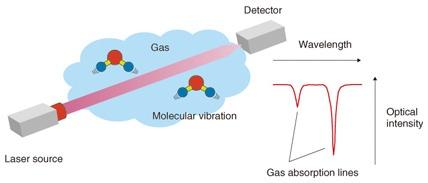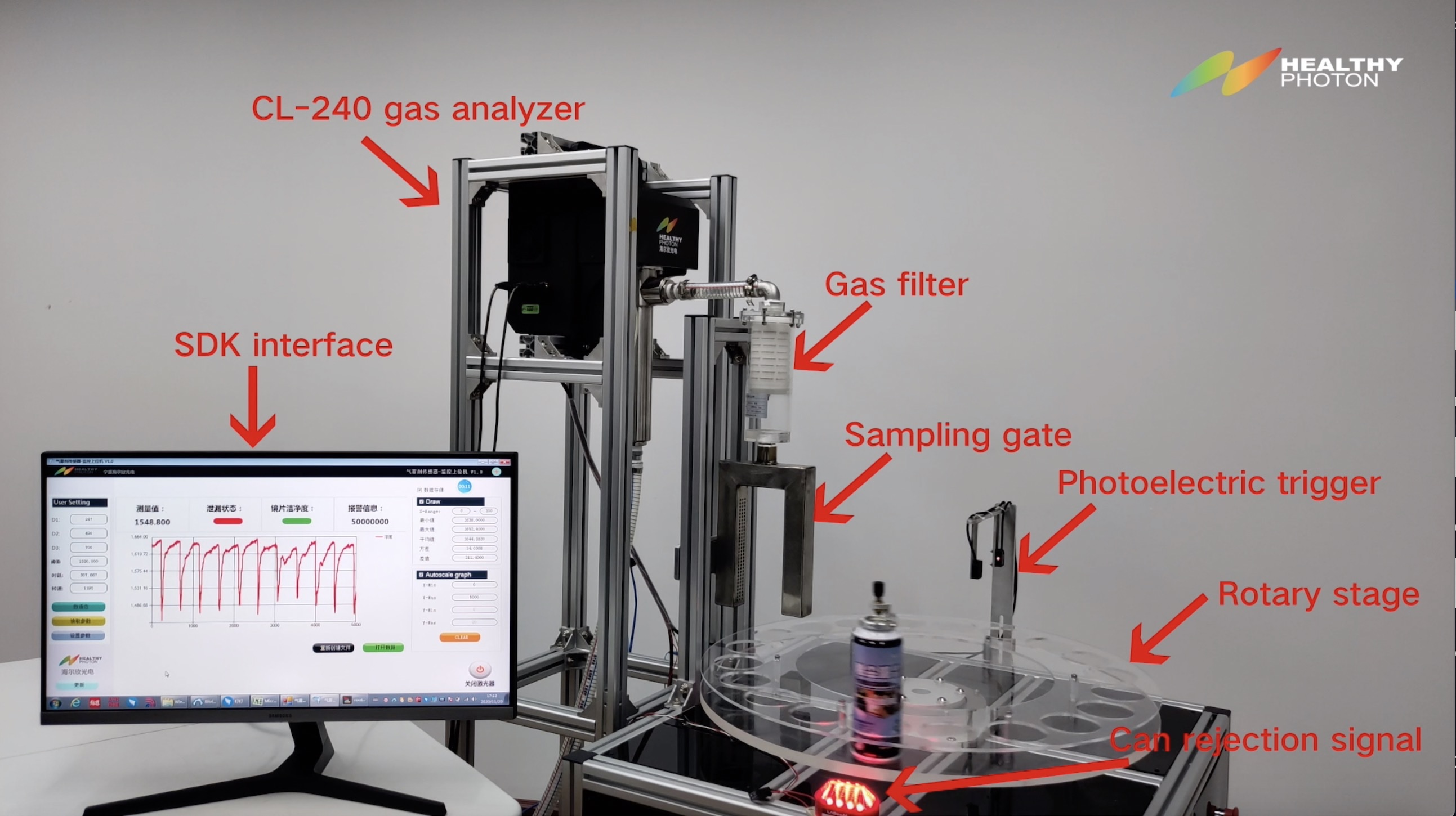 Home - Carbon Asset Data Service - Applications - Online Aerosol Cans Leak Detection: Water Bath or “QCLAS”?
Home - Carbon Asset Data Service - Applications - Online Aerosol Cans Leak Detection: Water Bath or “QCLAS”?
Online Aerosol Cans Leak Detection: Water Bath or “QCLAS”?
Why do we need aerosol can leak detection?
In the packaging industry, it is necessary to carry out seal performance tests for the tank products such as aerosol filling and compressed gas to ensure safety and product quality. The propellants in aerosol cans are usually highly hazardous (e.g., propane mixtures, dimethyl ether, etc.). It may cause an explosion if flammable gases or liquids are released. Therefore, the European Union and international regulations on the transport of dangerous goods require that each aerosol cans should be tested for leakproofness before being exported.
What is the shortage of the traditional water bath techniques?
The hot water bath testing technique is a traditional production line developed for Aerosol cans leak detection. Workers need to do the pressure check by putting the filled aerosol cans into a giant hot water pool. Studies have shown that this method can detect leakage rates as 8× 10-3 mbar.l.s-1 (equivalent to one bubble per second). It is sufficient to prevent explosion during transportation, distribution, or consumer use.
Fundamentally, heating aerosol cans is really risky (an explosion of a can could cause dozens or even hundreds of cans also exploding.) although related accidents have been very rare nowadays. However, there have been several huge accidents in history, due to thermostat failure and serious overheating. The production lines of aerosol can in some developing countries today may not meet the high standards described above, therefore risks of water bath technique still exist.
The water bath technique has many other problems either. First of all, this method is really costly for taking up a large amount of space in the factory and requiring significant energy consumption to maintain the water temperature at 122°F (50°C). Its power consumption is more than 50 kW when running at a rate of 500 cans per minute. Also, the expensive chemicals are often added to avoid rust, discoloration, and water stains on cans, and to keep the water clean for visual inspection. The water bath technique is also prevented from all the thermal conductive products. Therefore, a large number of international packaging companies are looking for more secure, costless, and efficient solutions for can leak detection.
The basic principle of Quantum Cascade Laser Absorption Spectroscopy (QCLAS) is to analyze the spectral intensity absorbed by the target gas, at a specific wavelength and obtain the concentration of trace gas. It has been widely used in trace gas analysis. With an optical sensor that ensures high sensitivity, short response time, and non-contact measurement, QCLAS is very suitable for real-time aerosol cans leak detection on the production line.

Figure 1: Technical sketch for “QCLAS” technology
HealthyPhoton is a company that focuses on high-precision gas detection technology for industrial processes and environmental monitoring. AeroNoseTM series products integrate the world’s best laser-based sensing technology and AI algorithms. The high sensitivity could meet the high requirements for the can leak detection tests. The analyzer machine requires a very small area and has a simple production line installation, which can offer a fully automatic, more efficient, more energy-saving online aerosol can leak detection to our customers. 21 century is the age of stereo-information, the QCLAS technique has great potential to replace the traditional water bath method.

Figure 2: HealthyPhoton’s AeroNoseTM aerosol can leak detection module
The advantages of AeroNoseTM series products over traditional water bath:
- Smaller modular designation: Facilitating for the integration of production lines; high reliability and low maintenance cost.
- Low power consumption: Replacing the high energy consumption of water bath tests.
- No heating: Avoiding potential safety hazards caused by can heating.
- No soaking: Avoiding corrosion and discoloration of the cans.
- No human visual inspection: Avoiding potential inattention error; saving labor costs.
- Quick response: The detection speed is up to 240 cans/min.
- High sensitivity: Aerosol leakage detection (propane, butane, liquefied petroleum gas, dimethyl ether, CO2, etc.) sensitivity up to 2 × 10-3mbar.l.s -1, meets EU aerosol can transport standards.
- Real-time monitoring: Giving feedback in real-time on the screen.

Product Demonstration
The AeroNoseTM series of aerosol cans leak detection equipment of HealthyPhoton has successfully cooperated with many domestic and foreign customers. The figure shows AeroNoseTM's CL-240 series delivers 240 can-per-minute online leak detection and also removes the flunked cans accurately on a simulated turntable.

Figure 4 has shown each part of the AeroNoseTM product:
- Photoelectric trigger: The starting point for each aerosol can to enter the area to be inspected.
- Sampling gate: gathering sampling gases
- Gas filter: filtering dust particles in air samples
- CL-240 gas analyzer: The filtered sampling gas around the aerosol can is quickly analyzed. Once the aerosol leakage is detected, the elimination signal is triggered.
- Can rejection signal: For demonstration, a red light is used instead of a real can blower. (generally non-contact). The unqualified can would be eliminated from the production line.
- Vacuum pump: An Imported large flow vacuum pump is used to provide energy for gas sampling with high- speed gas concentration analysis. It is located downstream of the gas path of the entire system which is not shown in the figure.
 Tel:+86-400 961 6990 Email:info@healthyphoton.com
Add:Room 305, Building 1, Zhongchuang Science Park, Jinyuan Road, Panhuo Street, Yinzhou District, Ningbo City,China
Tel:+86-400 961 6990 Email:info@healthyphoton.com
Add:Room 305, Building 1, Zhongchuang Science Park, Jinyuan Road, Panhuo Street, Yinzhou District, Ningbo City,China


